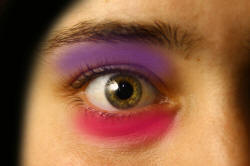Mistakes: slips and errors
 |
We all make mistakes |
 |
Slip or error? |
Traditionally in English Language Teaching, we make a distinction
between two types of mistake: an error and a slip. Errors
are caused by a lack of language knowledge or communication strategies and slips are caused by
tiredness, inattention or just having too much to think about at the
time.
For example, two of the following are just slips which can be ignored
(unless they persist) but three are real errors that may need us to do
something constructive in the classroom. (All of them are real,
noted in the classroom, by the way.)
Can you identify which is which?
Click here when you
have an answer.
- He go fishing every Sunday (advanced learner talking about his father)
- There are stone stairs down to the beach (low-level learner describing a picture)
- The house's roof is blow off (intermediate learner summarising a newspaper report about something which happened last week)
- The car won't starting because something is wrong with the engine (intermediate-level learner explaining a problem)
- Please give that me (upper-intermediate learner asking a classmate to pass a pen)
Right. Numbers 1, 4 and 5 are just slips or mistakes. It's unlikely that an advanced learner doesn't know that it should be he goes. It's also unlikely that an intermediate speaker doesn't know that won't is followed by the infinitive, not the -ing form and that an upper-intermediate student doesn't know that it should be it not that in this case.
Numbers 2 and 3, however, are real errors. In 2. the speaker clearly doesn't have the word steps in his or her vocabulary and in 3. there are lots of errors: the form of the genitive (it should be the roof of the house), the form of a passive (it should be the verb be followed by the past participle, blown) and the tense of the verb (it should be was or has been).
 |
Two views of errorWith which of the following do you have
the most sympathy? View 1:
errors made by students are evidence that something has gone
wrong in the teaching-learning process. |
Here are some comments. There is no
right answer to this question but you should know that what you believe
about error is likely to affect how you handle it.
View 1: is often held by those who believe that learning a language is
mostly about forming good habits and, through lots of practice an
repetition, we can get the point where we are producing correct language
automatically, almost without thinking.
View 2: is often held by those who see language learning as a process of
thought: learning by testing hypotheses, adjusting our theories,
comparing what we say with what we hear and noticing gaps in knowledge
for ourselves.
These are fundamentally different ways of seeing the process.
 |
How do the different views change how we handle error? |
Well, how might they? Think for a moment and then click here.
- If you hold view 1:
- You may feel it's your duty to correct every error as soon as it's made for fear that otherwise the learners will acquire bad language habits. You may also try to avoid putting your learners in a situation in which errors are going to happen.
- If you hold view 2:
- You will probably be rather more relaxed about error and focus only on those which are important for the purposes of what you are teaching at the time or which seriously get in the way of communication. Note that none of the errors in the first list of five makes the learner's meaning unclear.
Interlanguage
This is a key concept and describes where the learners' current language mastery stands on a scale from knowing nothing of the target language to complete mastery. Diagrammatically, it can be pictured like this:

It is, of course, crucial to know where a learner's interlanguage currently is. There are three reasons (at least) for this. Can you come up with them? Click when you've made a note (or at least thought about it!).
| Reason 1: | it tells us what the learner is likely to know already and that helps us plan what to teach. |
| Reason 2: | it helps us to decide what to correct in class. There's little point in trying to correct a very elementary student who is trying to produce a complex third conditional form with a modal auxiliary verb because it will take too long and probably confuse the learners. |
| Reason 3: | it helps us to recognise whether an error should be corrected by you or whether the error can be self-corrected by the learner. |
 |
Handling error in the classroom |
The following assumes that you are closer to those that hold view 2 than view 1.
There are three main steps:
Step 1: RECOGNITION
This may sound obvious. After all, we all know when something
is wrong, don't we?
Usually, yes but there are two sorts of error we need to be aware of
where it isn't so clear:
- Receptive error
- We can make a mistake in understanding what we read or hear so it is important that we have ways in the classroom to find out whether something has been adequately understood or not. To do that, we ask questions or make sure the language has a clear context so we can judge.
- Covert error
- If, for example, a student says, "She has been to London.", how do we know if it is right or wrong? The form looks and sounds OK but the learner might have meant, "She went to London." or "She has gone to London." and that's another reason we need a clear context for all the language we practise in the classroom.
Step 2: EXPLANATION
Can you think of any reasons why students may make errors?
Click here when you have thought of something.
- Ignorance
- the learner may simply have never learnt the form of the meaning and is just stabbing in the dark. This is most common at lower levels because that's where learners' needs often outstrip their abilities to produce language.
- Overgeneralising the rule
- sometimes, when a 'rule' has been learned, learners will over-extend it. For example, if you have learned the rule to add -ed to make a past tense, it seems logical to form catched. Equally, over-extending a rule might lead to the production of wonderfuller.
- First language interference
- all learners, especially adult ones, will draw on language(s)
they know to try to figure out a new one. This is most obvious
in the area of pronunciation, of course, but occurs frequently in
other areas:
Structure: the learner's first language may have a structure that looks similar but means different things. For example, the German structure of ich habe gesehen [I have seen, literally] often is better translated into English as I saw rather than I have seen. That's only one reason for finding out a bit about our learners' first languages.
Lexis: many languages, and not only European ones, have words which look the same but have different meanings. For example, simpatico in Italian means nice or friendly, sensibel in German means sensitive and un smoking in French is a dinner jacket. There are many hundreds of these so-called false friends. There's a set of exercises on this site focused on false friends.
Appropriacy: in many languages, such as Greek, it is perfectly acceptable, for example, to go into a shop and state I want ...or Give me ... with no please to soften the instruction. That will not work well in most English-speaking cultures.
Step 3: REMEDY
Here is where teachers need to think on their feet. There are
questions to ask whenever you hear an error. What might these be?
Click here when you have thought of
some ways to handle error.
- Question 1: am I going to correct this?
- If the error isn't holding up communication and has nothing to
do with the subject of the lesson, it may be that correcting it will
lead you off on a tangent, chasing red herrings and serve to slow
down the lesson and confuse the learners. If that's the case
ignore it.
If, on the other hand, the error is impeding comprehension or is made in the language that is the target of what you are doing, then you will have to deal with it. - Question 2: do I need to correct this?
- Very often, learners can correct their own production so a quizzical look or stopping learners and getting them to retrace their steps and reconsider may be more effective than your correcting the error.
- Question 3: can anyone else correct the error?
- If the learners can't correct their own errors, perhaps someone else in the class can. If you think this is the case, give them the chance to do so.
- Question 4: how will I correct?
- A last resort is normally to give
the correct answer yourself. Often, learners can be led to discover
the right answer with questions and suggestions such as "There's
something wrong with the order of the words.", "What preposition do
we need here?", "What tense should this be?", "Are we talking about
tomorrow or today?", or "Is this a long 'a' sound or a short one?"
and so on.
If all else fails, however, there are, obviously, times when providing the right answer is the best approach providing you make sure that the learner can produce the correct language independently after you have done so.
| Related guides | |
| how learning happens | for the guide to some major theories of learning |
| feedback | to see how the type feedback which is given can affect how error is handled |
| the in-service guide | for a more technical and fuller guide to error |
Click here for a test in this area.
